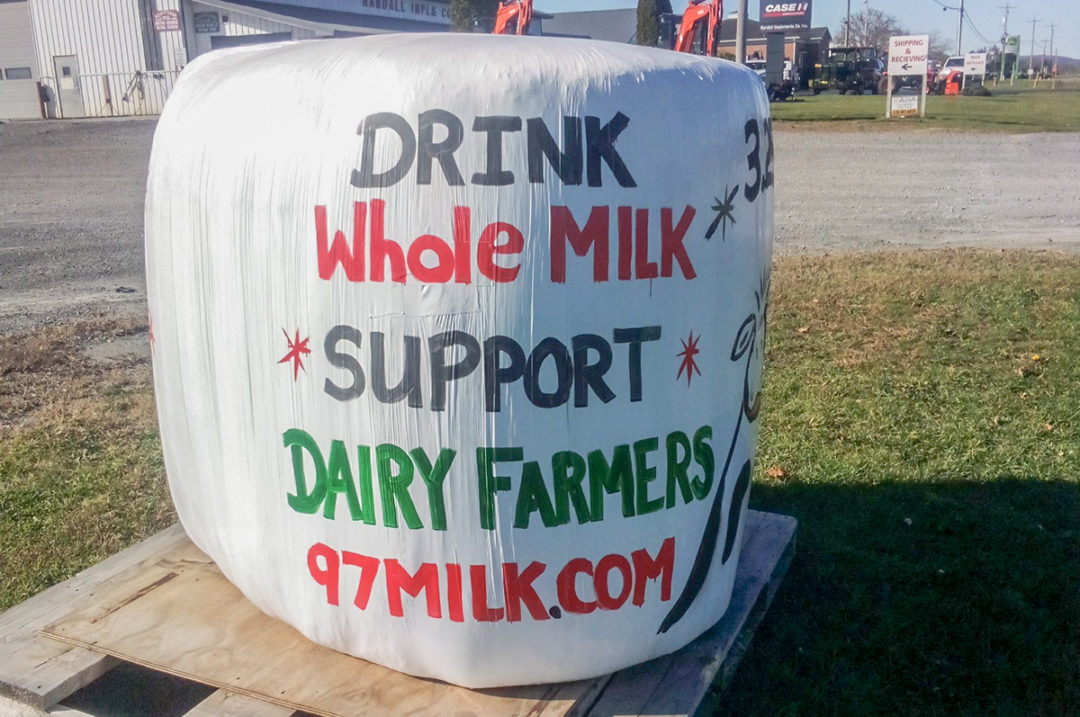New York dairy industry members are expanding the mission of “97 Milk,” sharing milk education with consumers and promoting the passion dairy farmers have for their craft.
97 Milk, a 501(c)(3) non-profit organization, began with a group of southeastern Pennsylvania dairy farmers and agribusiness professionals in 2019. Since then, the in-person and online efforts to promote whole milk consumption and make it available in schools has generated attention and action in surrounding states.
Read “Grassroots effort to promote whole milk picks up steam in its third year” in the Sept. 12, 2022 issue of Progressive Dairy.
“I love milk, and it was brought to my attention that it is illegal to have whole milk or 2 percent milk in schools,” says Jay Hoyt, feed salesman, former dairy farmer and 97 Milk volunteer in New York. “I also read that 50 percent of milk that kids take goes in the garbage because they do not like it, so I thought something had to be done about it.”
Duane Spaulding, retired New York dairy farmer and feed truck driver, fell in love with the educational aspects of 97 Milk after seeing the first round bale promoting whole milk from Pennsylvania dairy farmer Nelson Troutman. Like Spaulding, Ann Diefendorf, DHIA milk tester, dairy farmer and longtime dairy promoter, saw the initial impact of 97 Milk through the bale board advertisements, now called “educational bales,” and wanted to continue the work.
“I had frustration with education and promotion of whole milk over 30 years ago,” Diefendorf says. “The whole milk label does not say 3.25 percent fat or list it as 97 percent fat-free, so when I saw the first bale, I wanted to get in on these efforts.”
As a group, Hoyt, Spaulding and Diefendorf collaborate to promote the benefits of whole milk and 97 Milk talking points through painting hay bales, traveling to fairs and providing whole milk samples and education to consumers.

“I do it because I love farmers, I love milk, and I want to see farmers around here,” Hoyt says. “I like seeing cows on the hillside. I believe 50 years from now when I am gone, my grandchildren will want to see cows, and they might want some food to enjoy as well.”
Expanding 97 Milk promotion efforts
The expansion of 97 Milk to states like New York, Vermont and Connecticut is a grassroots effort resulting from passion for dairy farms, milk education and getting whole milk back in schools.
“We are not paid, we are not lobbyists, and this is out of our own pocket and time,” Spaulding says. “Ann’s family is a fifth-generation farm, and I want to do anything in my power to keep America dotted with our farms.”
The group originally connected with the five 97 Milk board members in Pennsylvania to share their expansion goals to New York. From there, they began promoting whole milk at local, state and regional events and working with local legislators to create policy initiatives for adding whole milk back into school lunch programs.
“When people look at you and your materials and thank you for trying to get whole milk back in schools, it makes you want to do more,” Diefendorf says. “If someone calls us from another fair or event, we go because there is a need to educate. I do not want my kids to say to me, ‘Why didn’t you do something about trying to change this situation?’”
As the 2023 Farm Bill develops, endeavors to promote 97 Milk on a national scale have come in the form of the “Whole Milk for Healthy Kids Act of 2021” (H.R. 1861), authored by U.S. Rep. Glenn “GT” Thompson (R-Pennsylvania). As the new chair of the House Agriculture Committee in the 118th Congress, he is actively encouraging more members of Congress to sign on in support.

“Farmers know that environmental and animal rights activists are problems we face in the dairy industry,” Hoyt says. “But many do not know that they cannot even sell their product in schools.”
Tasting the difference
Promotion of whole milk has also come in the form of sharing the beverage at family reunions or local church fundraisers.
“This is the third year that a local church has done a chicken and biscuit dinner, and we wanted to hand out whole and chocolate milk samples,” Spaulding says. “In an hour-and-a-half, 300 meals were sold, and 600 bottles of milk were handed out with those meals.”
As Diefendorf continues painting bales, she hopes messaging on whole milk’s nutritional benefits such as containing 21 minerals, 13 vitamins and being nature’s nutrition powerhouse, will resonate with consumers and legislators alike.
“When I paint on a bale ‘Whole milk tastes the best,’ that is the truth,” Diefendorf says. “Parents are flabbergasted when they hear whole milk is not allowed in schools.”
A community of support
97 Milk efforts in New York have received support from local dairy farmers, agribusinesses and milk processors. Dairy farmers want hay bales promoting whole milk in their front yards and small, local processors are contributing to the milk that is donated and distributed for events.
“This affects all of us in the dairy industry,” Spaulding says. “If we do not do this, there are farmers, feed mills and machinery places going out of business. We want to play a part in saving these groups, and we all must stand up and help each other.”
As Spaulding, Diefendorf and Hoyt continue local efforts on behalf of 97 Milk, the team is collaborating with neighboring states and dairy industry events.
“Farmers are seeing more about 97 Milk and calling about expanding efforts in other states,” Spaulding says. “97 Milk reached out to us about the New York State Fair and were wondering if we could come in the calf and heifer area of the fair for promotion.”
Events such as the Tunbridge World Fair have also invested in the mission of the non-profit, where the group distributed over 440 half gallons of whole milk to attendees. The team is thankful for articles in local and national publications that focus on the value of promoting whole milk.
Continuing the work
To activate more understanding of 97 Milk and its mission, the team would like to see more engagement from the House Committee on Education and Labor to hear what children and parents have to say about putting whole milk back in schools as a choice.

“Kids share that low- and no-fat milk tastes gross in schools,” Diefendorf says. “They don’t drink it.”
The group expresses their thanks to local and state legislators on gaining exposure to 97 Milk and encourages producers in other states and regions to promote 97 Milk in their areas using banners, stickers and handouts from the organization’s website (www.97milk.com). Education is key to consumer and institution activation.
“Education is power,” Diefendorf says. “We need to keep forging on.”
Overall success for 97 Milk promotional efforts includes connecting consumers with dairy producers, saving dairy farms and helping America to be food secure through dairy products.
“If we can get whole milk in schools, that means we get kids back to drinking what they like,” Hoyt says. “We will hopefully prevent losing a generation of milk drinkers.”
Jay Hoyt’s 6-point plan to save dairy farms
1. Educate parents on the value of milk.
2. Get whole and 2% milk back in schools.
3. Serve milk ice cold.
4. Market milk with light-protecting packaging.
5. Advertise milk directly to parents.
6. Put milk on the shelves for consumers to buy.





